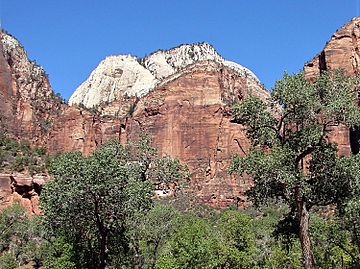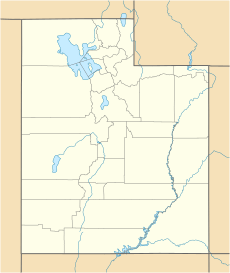Castle Dome (Zion) facts for kids
Quick facts for kids Castle Dome |
|
|---|---|

Southeast aspect, from Zion Lodge
|
|
| Highest point | |
| Elevation | 7,060 ft (2,150 m) |
| Prominence | 540 ft (160 m) |
| Isolation | 1.00 mi (1.61 km) |
| Parent peak | Point 7180 |
| Geography | |
| Location | Zion National Park Washington County, Utah United States |
| Parent range | Colorado Plateau |
| Topo map | USGS Temple of Sinawava |
| Geology | |
| Age of rock | Jurassic |
| Type of rock | Navajo sandstone |
| Climbing | |
| First ascent | 2015, Stih and Purcell |
| Easiest route | class 5.2 climbing |
Castle Dome is an amazing mountain peak in Zion National Park, located in southwest Utah, United States. It stands tall at about 7,060 feet (2,152 meters) above sea level. This impressive rock formation is made mostly of Navajo Sandstone, a type of rock that gives Zion its famous red and orange colors.
Castle Dome is found northwest of Zion Lodge, a popular spot for visitors. It rises dramatically, about 2,800 feet (850 meters), above the floor of Zion Canyon. The mountain sits on the west side of the North Fork Virgin River. This river helps carry away rainwater from the mountain.
You can find Castle Dome between two canyons, Behunin Canyon and Heaps Canyon. The beautiful Emerald Pools, a favorite hiking area, are right at the base of this mountain. Castle Dome has many famous neighbors, including Mount Majestic, Cathedral Mountain, The Great White Throne, Red Arch Mountain, Mountain of the Sun, and Lady Mountain. The name "Castle Dome" was officially given to this peak in 1934.
Weather at Castle Dome
The best times to visit Castle Dome are during spring and fall. The weather is usually mild and pleasant then. This area has a "cold semi-arid climate." This means it's a desert climate, but it can get cold in winter.
The coldest month usually has an average temperature below 32 °F (0 °C). Most of the yearly rain falls in spring and summer. The region gets less than 10 inches (254 millimeters) of rain each year. Snowfall in winter is usually light.
Gallery









